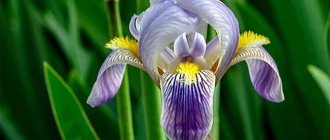Morning glory is often called Cypress creeper and is a member of the Convolvulaceae family. The flower arrived in our country from Mexico and very quickly took a leadership position.
Description
Ipomoea quamoclite, or as it is also called cypress vine, is a prominent representative of the Convolvulaceae family. This attractive plant came to Russia from Mexico, and it quickly won the love of domestic gardeners. And all thanks to its attractive appearance, fast growth and non-capricious character.
Ipomoea quamoclite is a tropical annual vine. It has strongly twisted shoots reaching a length of up to 5 meters. The leaves of this variety have an unusual shape, resembling a dissected and open fan.
But the main attraction of quamoclite lies in the tubular, star-shaped buds that densely cover the shoots of the vine from early summer until October. Morning glory petals are usually colored red and pink. But there are specimens with snow-white buds. The peculiarities of the culture include the fact that the flower stalks bloom in the morning and evening, and at midday they close.
Popular types
There are several varieties of quamoclite vine, but only the following species take root in our gardens:
- Slaughter's Quamoclite. This hybrid annual grows up to 1.5 meters in height. The variety is distinguished by bright red buds reminiscent of a cardinal's robe. The leaves of the vine are strongly dissected and reach up to 7 cm in length. Slaughter's quamoclite blooms from mid-summer until the end of September.
- Ipomoea pinnate. The variety is characterized by fast growth and openwork leaves of a dark green color. Star-shaped buds cover the vines from early August to mid-October. The petals are colored carmine red or pink. Some varieties have snow-white buds.
- Quamoclite is fiery red. This variety grows up to 3 meters in height. It has tubular, bright scarlet buds with a yellow throat and a diameter of about 1 cm. Unfortunately, the vine does not bloom for long - from June to July.
- Quamoclite lobed. The variety, also called star bindweed, features strong reddish stems that grow up to 3 meters in length. The leaves of the vine are three-lobed, heart-shaped. Near each of them, three thin stipules are formed. The buds of the variety are drop-shaped and reach 2 cm in length. As they grow, they change their color from red to orange, and then to soft cream. The buds densely cover the branches from early August until the first frost.
Each of these varieties will decorate your site. But to really add color to your landscape, plant a mixture of morning glory quamoclite colors. These vines are distinguished by multi-colored buds.
Use of plants in garden decoration
Examples of decorating a garden with morning glory
You can use a mixture of colors of morning glory kvamoklit to decorate gazebos, open terraces, and balconies. A lattice fence decorated with such a plant will look great. If there are arches on the territory, then feel free to plant the crop next to them to create a real work of art. You can also plant the vine in garden vases located on a hill.
Selecting a location
To grow morning glory quamoclite, choose bright places, because in the shade the richness of the petals noticeably fades and the number of buds decreases. In addition, select a site for the vine that is protected from sharp gusts of wind. The ideal location would be the south side. But the vine will also take root in the east. The main thing is that the site is not located on a hill.
The plant prefers well-drained, loose, but not too fertile soil. In soil rich in nutrients, the crop fattens and increases green mass to the detriment of buds.
Features of planting morning glory quamoclite
As a native of tropical forests, morning glory quamoclite requires special growing conditions. You can plant it directly into the ground; this is done in late spring (mid-April-early May). After sowing, seedlings are noticeable after 25 days, but the time of their appearance depends on the temperature of the soil and air. As soon as small sprouts appear, they are thinned out so that there is a plant for every 20 cm. As growth increases, they are planted again, leaving 40 cm between the vines.
Growing morning glory quamoclite from seeds at home
The method of propagation by seeds is the most effective for morning glory quamoclite. You need to sow them in containers for seedlings, preferably peat pots (no more than two seeds per one), do this in March. Immediately before sowing, the seeds must be placed in warm water for a day. If after 24 hours they have not swollen, pierce the shell, then put it back into water. Use neutral or low alkali soil. The soil must be loose.
Next, immerse it in the soil to a depth of no more than 1 cm, and then spill the soil. Cover containers with seedlings with cellophane film to create a greenhouse effect, thanks to which the seeds will quickly hatch. Place them in a well-lit place with a temperature of at least +20 °C. When 2 leaves appear, plant the seedlings in separate containers (about 2 weeks will pass).
It is important to maintain air humidity around 60-70%. Fertilizing is carried out only with complex fertilizers.
Planting seedlings in open ground
Ipomoea quamoclite seedlings are planted around the end of May, when repeated frosts are no longer expected. Make grooves no more than 3 cm deep, place the seedlings in them with a distance of 10 cm from each other. At the same time, it is not recommended to plant quamoclite deeper.
Sowing seeds in open ground
This method is recommended for the southern regions. However, in others this is not prohibited, the only thing is that sowing will need to be done at the end of April. This method involves late flowering.
In open ground, seeds are immersed to a depth of up to 3 cm, in contrast to sowing seedlings. Then pour warm water over it and cover with polyethylene. The film is removed as soon as the first shoots are discovered.
Due to its growth habit, the plant branches well. This must be taken into account when choosing a site. If you want to get a lot of flowers nearby, then you need to plant the seeds at a distance of 20 cm from each other.
Growing vines from seeds
Morning glory is a southern plant, so it is better to grow it using seedlings. Start the event in mid-to-late April. Ipomoea quamoclite seeds are quite resilient and retain their viability for a long time. But they should still be prepared before sowing. To do this, soak the grains for a day in water at a temperature of +50 °C. During this time they should swell well.
If this does not happen, then heat the shell of the grains with a needle, or lightly rub them with fine sandpaper. After this, soak the seeds again and wait until they swell.
This climbing plant has a tap root system and does not tolerate transplantation even at a young age. Therefore, in order not to injure the seedlings and not to pick the seedlings, germinate the seeds immediately in individual pots or on peat tablets. For seedlings, buy a special mixture. Or prepare a substrate consisting of equal parts of garden soil, peat and sand.
Sow the prepared grains to a depth of 2–3 cm. After sowing, sprinkle the soil with warm water from a spray bottle and place the plant in a bright room with a temperature of +20…+22 °C. The first shoots will appear within 6–8 days.
Growing and care
Landing
Landing place
Where morning glory quamoclite will grow, there must be light; the more shade, the fewer flowers there will be on the vine. In addition, the area must be free from drafts. The plant will feel good in the southern and eastern areas in the lowlands.
The growing soil can be loose with good drainage, but less nutritious. Thanks to the large amount of nutrients, the growth of green mass can be enhanced.
Important! When growing morning glory quamoclite, it will need support from any available material. This can be stretched twine or thick wire or bars. When the shoots appear, they must be fixed in the desired direction on a support, tying them with thin ropes without effort.
Rules for planting vines
Sowing seeds in open ground usually begins in April; if you are late, they may not ripen. Such planting is possible if sudden frosts that could harm the plant are not expected.
Morning glory seedlings
Since morning glory is a heat-loving plant, it is advisable to plant it as seedlings, but in this case you need to adhere to certain rules, because the plant does not like transplanting.
Interesting! If during preparation the morning glory seeds do not swell, they can be lightly pierced with a needle or rubbed with fine sandpaper, then add water again.
Order:
- Quamoclite seeds have good germination, but to increase it they can be prepared by soaking in warm water for 24 hours to swell.
- In order not to torment the plants with transplants and picking, it is better to sow the seeds in peat tablets or pots. For seedlings, you can use a special soil mixture or garden soil with peat and sand.
- The seeds in the container are deepened by 2-3 cm, after which the surface of the soil is slightly moistened by spraying. Until the sprouts appear, the pots are kept in a bright and warm room at a temperature of 22 degrees, this takes a little more than a week.
Interesting! The rapid growth of morning glory begins with germination. Before the seedlings go into open ground, they can reach 1.5 meters in length. To prevent them from getting tangled while they are growing, they can be let on a stretched rope near the pots. During growth, the young plant should be in moist soil and in conditions of sufficient lighting; if this is not the case, you need to use a phyto lamp in the evening.
Planting morning glory in the ground is possible when stable warm weather sets in, usually this time occurs in the second half of May.
The seedlings are placed in a prepared trench, 30 cm deep, by transferring them together with a clod of earth so that the roots are not damaged. The distance is maintained at 20-25 cm.
Long shoots of morning glory may be damaged during transportation; to reduce the risks, they can be wrapped in newspaper or placed in a deep container, directed in a circle.
After planting, the soil is watered abundantly and mulched with peat, which helps to prolong moisture and protect the soil from the appearance of weeds. It is better not to use fresh manure as a mulch layer; it can burn the young root system of morning glory.
Plant care
The morning glory flower quamoclite needs careful care after planting. During the period of intensive growth, the plant needs a lot of sunlight, this will contribute to the growth and formation of the crown, which is especially important when decorating gazebos and verandas.
For abundant flowering, quamoclite requires humidity; its high level can completely regulate the number and brightness of buds. With abundant watering, the growing area should not turn into a swamp; it must have time to dry. The roots of morning glory quamoclite grow in depth, so the close occurrence of underground water can lead to rotting of the root system.
The vine should be watered in the morning or evening no more than three times a week, using warm water, the temperature of which does not differ from the soil. Each plant needs 1-1.5 liters at a time.
Ipomoea does not need a large amount of fertilizer, but during flowering it may need additional fertilizing consisting of a complex of minerals. Application frequency – 1 per week during the period of active growth.
Problems during cultivation
Often, quamoclites can be affected by spider mites, and if you do not get rid of them, the flowers may die. Treatment in this case is simple; it is enough to treat the morning glory with very cold water several times a week. If this method does not work, you can resort to special drugs from the store. For prevention in the evening, during extreme heat, the vine can be sprayed with cold water.
Yellowing of quamoclite leaves indicates a lack of iron; the situation can be changed by additional fertilizer or digging rusty nails into the ground.
Curled leaves of the vine in the absence of any pests are an indicator of an excess of minerals. In this case, you need to stop feeding for 3 weeks.
Important! Replanting a plant is possible only as a last resort; this is a very stressful event for it. Morning glory may not take root in a new place or may begin to hurt severely.
Collecting seeds for sowing
Since morning glory is an annual plant, the seeds must be collected every year after flowering. To do this, you need to remove the dried buds; in the back of each of them you can find a pod with seeds.
Only material collected from mature pods is suitable for sowing. The seed pod is hard and when pressed, it cracks and opens.
The extracted seeds should be spread on paper or a plate and dried for 2-3 days. They need to be stored in a paper bag; germination lasts for 5 years.
Seedling care
Ipomoea quamoclite seedlings grow quite quickly. And before planting in the ground, young vines can reach 1.5-2 meters in length. To prevent thin stems from getting tangled with each other, pull strings near each pot and send shoots along them.
When caring for seedlings, regularly moisten the soil, preventing it from drying out. In early spring, the vines may not have enough light, so it is advisable to additionally illuminate the seedlings with a phytolamp in the morning and evening, as well as in cloudy weather.
Planting in open ground
Plant the seedlings in a permanent location when the weather becomes warm and the risk of night frosts disappears. As a rule, in the middle zone this occurs in mid-to-late May. For seedlings, dig a trench with a depth of 25–30 cm. Plant young vines along with a ball of earth using the transshipment method, being careful not to damage the roots. Maintain a distance of 20–25 cm between plants.
To prevent the thin shoots of the crop from breaking during the event, wrap the pot with the vine in newspaper, capturing the lower part of the stem. Place the plant in a bucket and lay the rest of the flexible branches along the walls of the container, directing them in a circle. In this form, take the plant to the planting site, and then carefully remove it from the bucket.
After the event, water the soil well and mulch its surface with peat or sawdust. This layer will help retain moisture and also protect the plant from weeds. Do not use fresh manure as mulch, as it will burn the plant's tender roots.
Growing
Growing a vine is not difficult. Friendly shoots quickly stretch out, becoming abundantly covered with leaves. We mainly grow pinnate quamoclite (cypress vine). It is not worth replanting; the plant may die. It is better to use the seed method rather than the seedling method.
Other types of transplantation are not afraid.
This liana prefers light, fertile soil, and a place sufficiently illuminated by the sun.
Planting morning glory quamoclite
Seeds are sown in the ground in the second half of April. If this is done later, the plant will not have time to form new seed material.
If the spring is cold, it is better to use seedlings for propagation. To do this, in March, the seeds are sown in prepared boxes with soil mixture (you can choose a universal option). After the end of frost (at the end of May), the seedlings are planted in a permanent place in the garden.
It is recommended to plant plants at a distance of at least ten centimeters from each other. Planting depth is about three centimeters. The seedlings should not be buried.
How to care for a liana
Red morning glory quamoclite is an unpretentious plant. But in order to achieve non-decorativeness, you need to create comfortable conditions for the culture. The following agrotechnical measures will help with this:
- regular and abundant watering;
- periodic feeding;
- loosening the soil;
- construction of a support;
- prevention of diseases and pests.
Next, you will learn about these rules for growing morning glory quamoclite in more detail.
Support
Without additional support, the vine shoots will intertwine with each other, and the plant will turn into a lush green bush that cannot be untangled. Of course, it looks attractive in its own way, but such crops do not produce buds. Therefore, in order to achieve long-term flowering, install supports next to the morning glory and direct the growth of its shoots along them. For this purpose, use any available materials - chain-link mesh, gratings, arches, pergolas. In addition, the walls of buildings, gazebos, and verandas will provide support for the plant.
Where can I plant morning glory quamoclite ↑
- Twinkling Stars are ideal for camouflaging unattractive walls and fences.
- They can be grown in containers on a veranda or balcony so that they curl beautifully around the railing. If you stretch the ropes to the ceiling, you will get a green shady corner.
- Another good idea is to plant quamoclite next to tall trellises or make a mesh of tensioned wire to separate the seating area from the vegetable garden, for example. Open most of the day, the colorful buds and beautiful leaves will truly create a piece of paradise.
- If you plant them under a tree, the vine will wrap around it beautifully.
Watering
Morning glory is a moisture-loving plant. And during the growth of green mass, as well as during the formation of buds, the vine needs regular and abundant moisture. Water the crop every three days and do not allow the soil to dry out. But make sure that moisture does not accumulate at the roots and the area does not become waterlogged. Otherwise the plant will get sick. When the buds open, irrigation can be reduced. But the soil should not be allowed to dry out. Therefore, moisten the soil when its top layer dries.
The next day, after watering the morning glory kvamoklit, be sure to loosen the soil. This will improve air access to the roots, which will have a positive effect on the decorative appearance of the vine. To reduce soil moisture and loosening, mulch the plant's trunk circle with peat, fallen leaves or humus. This layer will retain moisture and prevent a dense crust from forming on the surface.
Conditions for growing Quamoclitus lobes
Landing place . Quamoclite lobe is a heat-loving tropical plant, tolerates minimum winter temperatures down to -5°C, and needs a warm, protected place in the open sun.
The soil . Prefers chalky or neutral, sandy soils. Soils that are too rich are not suitable for the plant.
Temperature . The optimal temperature for growth is +24°C, at night – not lower than +16…+18°C. At lower temperatures, plant growth stops.
Watering and humidity . Another condition for good plant growth is air humidity. It is recommended to sprinkle the plant on hot days. But under no circumstances should you do this in cloudy weather.
The plant requires quite a lot of water. However, the soil must be kept moist and not soggy, otherwise there is a risk of developing root rot. It is recommended to mulch the soil around the plant with a small layer of compost to retain moisture and prevent weed growth.
Feeding . Fertilize with liquid mineral fertilizer every 2 weeks. At the same time, observe the development. Overfed plants bloom worse, directing development to the formation of leaf mass. For young plants, use fertilizers with a predominance of nitrogen, and closer to the flowering period, replace them with phosphorus-potassium ones.
Quamoclit lobata, or morning glory (Ipomoea lobata)
Top dressing
To achieve special decorativeness and numerous flowers from morning glory quamoclite, it is important to fertilize the soil several times a season. Apply the first fertilizing two weeks after planting in open ground. Use complex compounds containing nitrogen as fertilizers.
When the plant begins to bud, feed it with phosphorus preparations. So, you will increase the number of peduncles. Apply fertilizer for the last time during active flowering. Now feed the vine with a potassium-phosphorus mixture. To prevent the preparations from burning the delicate roots, apply fertilizers in the evening. In addition, the day before fertilizing, do not forget to moisten the tree trunk well.
Subsequent landing
The plant is planted in the ground using seeds and often without growing seedlings. It is best to choose a place for planting that is sunny and warm. The plant is quite unpretentious in the choice of soil, and for its successful flowering and growth there must be enough light and warmth. But it is best to choose a piece of soil that is loose. You can add a little sand. This will allow the plant to have a very long growth period, during which it will bloom profusely.
It is best to plant seeds on the site at the very end of spring. Try not to plant the seeds too close to each other, maintaining a distance of 35-50 cm. At the time of planting the seeds, the soil should be dug up and, if possible, organic fertilizers should be added. It is advisable to cover the resulting area with synthetic material after planting.
Collecting seeds
To grow an attractive vine next year, be sure to collect seeds. To do this, inspect the plant and look for shriveled buds. Behind each of them there is a small round pod. The grains of morning glory quamoclite ripen in it.
Please note that seeds that you take from mature pods are suitable for further propagation. Their ripeness is indicated by their hard, brown shell. When pressed with your fingers, these boxes make a cracking sound and the doors open.
Remove the seeds from the pods and place them on a white piece of paper or saucer. Place the grains in a dry, dark place and dry them for 2-3 days. Then put the seed in a paper bag and store it. They retain germination for 5–6 years.
Diseases and pests
Ipomoea quamoclite is a plant with strong immunity. But when overwatered, caused by errors in care or prolonged rains, the vine becomes infected with fungal diseases: powdery mildew, white swelling, rust, and various rots. If such diseases occur, reduce watering. And then cut out all severely damaged shoots of the plant, and treat the crown with fungicides such as “Skor” or “Topaz”.
To prevent such diseases, for preventive purposes, during the growing season, spray the vine twice with copper-containing preparations, for example, “Radomil Gold” or “Acrobat”. And the biological agents “Fitosporin” and “Baktofit” also help prevent fungal diseases.
If you do not want to use chemicals, then treat the plant with whey diluted with water in a ratio of 1 to 1. For preventive purposes, spray the vine foliage with this solution every 10 days.
Ipomoea quamoclite is often attacked by pests, such as:
- Aphid. These insects are visible to the naked eye. They prefer to settle on the inside of the leaf.
- Leaf roller. The pest wraps the leaves of the vine and places the larvae in them. They gnaw large holes in the plates, which leads to the withering of the plant.
- Spider mite. This parasite cannot be seen with the naked eye. But it is recognized by a thin sticky web that appears on the corners of the attachment of stepsons and the leaves of the vine.
To get rid of insects, spray morning glory once or twice with insecticides. The drugs “Aktara” and “Confidor” cope well with all types of parasites. Carry out the treatment in the evening or in cloudy weather.
Reviews
It is not for nothing that red morning glory quamoclite is in demand among gardeners. After all, according to reviews, this vine is the best plant that can be used to hide landscape imperfections and decorate gazebos, fences and unsightly rooms. Its advantages include fast growth, unpretentious character and high decorativeness. In addition, the plant is resistant to most diseases and pests that attack similar types of vines.
In general, ensure proper planting and care of morning glory quamoclite, and it will definitely reward you with rapid growth and beautiful numerous buds. And to do this, strictly adhere to the recommendations given in the article.











